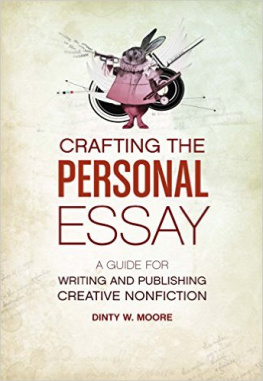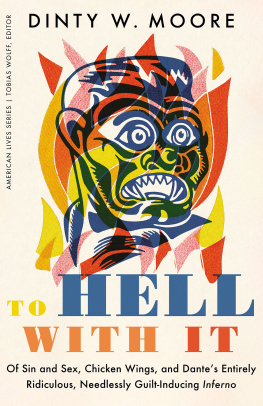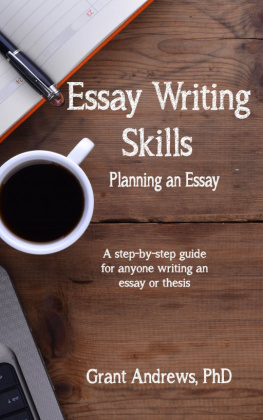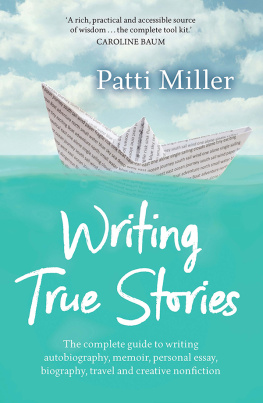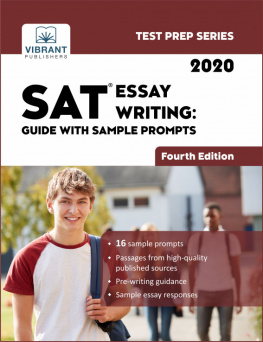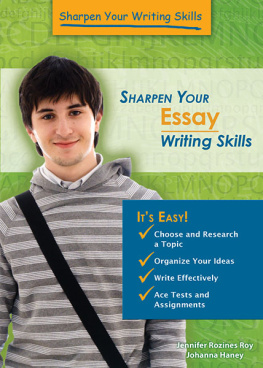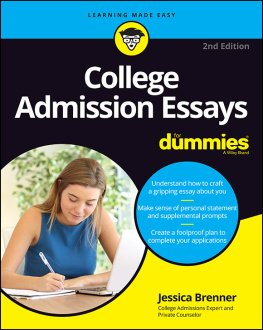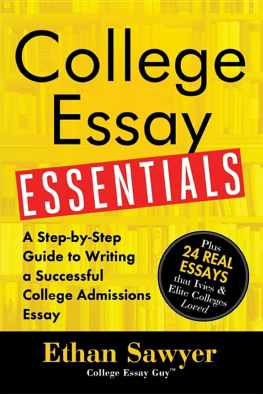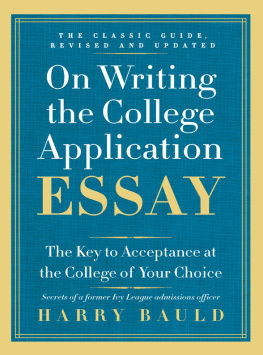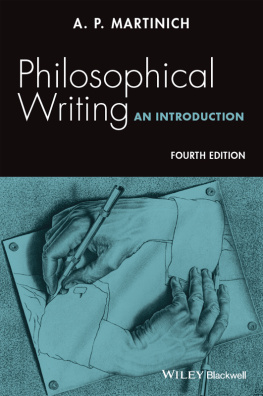CRAFTING THE
PERSONAL
ESSAY
A GUIDE FOR
WRITING AND PUBLISHING
CREATIVE NONFICTION
DINTY W. MOORE

CRAFTING THE PERSONAL ESSAY. Copyright 2010 by Dinty W. Moore. Manufactured in the United States of America. All rights reserved. No other part of this book may be reproduced in any form or by any electronic or mechanical means including information storage and retrieval systems without permission in writing from the publisher, except by a reviewer, who may quote brief passages in a review. Published by Writers Digest Books, an imprint of F+W Media, Inc., 4700 East Galbraith Road, Cincinnati, Ohio 45236. (800) 289-0963. First edition.
For more resources for writers, visit www.writersdigest.com/books.
To receive a free weekly e-mail newsletter delivering tips and updates about writing and about Writers Digest products, register directly at http://newsletters.fwpublications.com.
Distributed in Canada by Fraser Direct
100 Armstrong Avenue
Georgetown, Ontario, Canada L7G 5S4
Tel: (905) 877-4411
Distributed in the U.K. and Europe by David & Charles
Brunel House, Newton Abbot, Devon, TQ12 4PU, England
Tel: (+44) 1626-323200, Fax: (+44) 1626-323319
E-mail: postmaster@davidandcharles.co.uk
Distributed in Australia by Capricorn Link
P.O. Box 704, Windsor, NSW 2756 Australia
Tel: (02) 4577-3555
Library of Congress Cataloging-in-Publication Data
Moore, Dinty W., 1955
Crafting the personal essay : a guide for writing and publishing creative
nonfiction / by Dinty W. Moore.
p. cm.
ISBN 978-1-58297-796-6 (alk. paper)
eISBN: 978-1-5996-3200-1
1. Essay Authorship. 2. Autobiography Authorship. 3. English language
Rhetoric. 4. Creative nonfiction Authorship. I. Title.
PE1479.A88M66 2010
808.042--dc22
2010013106

Edited by: Scott Francis
Designed by: Terri Woesner
Cover illustration stockimages.com
Production coordinated by: Mark Griffin
dedication
For Susan A. Moore Smith with love and gratitude



about the author

Dinty W. Moore is the author of the 2008 memoir Between Panic & Desire (University of Nebraska), termed a quirky, entertaining joyride by Publishers Weekly. His other books include The Accidental Buddhist, Toothpick Men, and The Emperors Virtual Clothes.
Moores books have been translated and released in German, Italian, and Chinese editions, and he has published essays and stories in The Southern Review, The Georgia Review, Harpers, The New York Times Sunday Magazine, The Philadelphia Inquirer Magazine, Gettysburg Review, Utne Reader, and Crazyhorse, among numerous other venues.
A professor of nonfiction writing at Ohio University, Moore has won many awards for his writing, including a National Endowment for the Arts Fellowship in Fiction.
Moore was born in Erie, Pennsylvania, and holds degrees from the University of Pittsburgh and Louisiana State University.
He can be reached at panic.desire@gmail.com.
TABLE OF CONTENTS
PART ONE
WRITING THE ESSAY
PART TWO
REACHING READERS
INTRODUCTION: THE PERSONAL ESSAY, HERE AND NOW
Fill your paper with the breathings of your heart.
William Wordsworth
The personal essay is perhaps the oldest form of nonfiction prose, and yet it remains one of the most commonly misunderstood. Some people persist in the belief that the essay needs to be antiquated and moldy, while others claim the essay must follow a menu of one hundred creativity-destroying rules.
These misperceptions are unfortunate, because the personal essay is a wonderfully flexible and creative form, as fresh and inventive as the writer wishes it to be. In addition, the essay remains an ideal vehicle for satisfying that human urge so many of us feel to not just live year to year but to capture a bit of that life, to produce an enduring record of our better thoughts.
That is, after all, why so many people young and old, homemaker and trial lawyer, working and retired share the dream of being writers, of having others delight and marvel at what has been written.
We want to speak. And we want to be heard.
USING THIS BOOK
Crafting the Personal Essay: A Guide for Writing and Publishing Creative Nonfiction is designed to clear up the confusion about the form and encourage writers at all levels of experience to explore the flexibility and power of the personal essay, as it exists here and now. This book is meant to be a hands-on, creativity-expanding guide, intended to encourage new energy and fresh paths in your writing.
Part One includes key chapters isolating important elements of the essayists way of seeing and thinking alongside briefer chapters which isolate specific modes of essay writing, such as the lyric, the spiritual, and the gastronomic essay.
Part Two focuses on reaching potential readers, with chapters on establishing a regular writing routine, on revision, and on strategies for publication.
My suggestion is that you work through these pages slowly, with pencil in hand. I have provided more than one hundred prompts and writing exercises, and though it is unlikely that each and every one of them will spark you into action, my hope is that many of them will. Take the time to scribble your responses to the prompts, or to the examples provided in the various chapters, and save the notes and paragraphs you create. When you are done reading and writing your way through these chapters, you may find that you have a stack of essays waiting to be completed.
I will be suggesting various dos and donts along the way, and regularly alerting you to possible pitfalls, but there are really only two firm imperatives:
You must always keep an open mind, be willing to explore, and
Always be careful to bring your reader along on your journey. Writing is indeed a solo act, but the result is meant to be shared.
So lets get started.

PART ONE WRITING THE ESSAY

THE GENTLE ART OF THE PERSONAL ESSAY
One reason the essay is so misunderstood nowadays may be that well-intentioned but overburdened writing teachers from grade school through college have tried to drill us in the essay form, but in the end this instruction often amounted to little more than a series of awkward limitations.
Remember, for instance, the five-paragraph essay? In this boxcar-boxcar-caboose approach, the essay often seemed to have more thesis sentences than it did interesting ideas. Not only was the essay supposed to follow a strict outline, but every essay was supposed to follow the same strict outline, forever and ever, amen.
Next page
